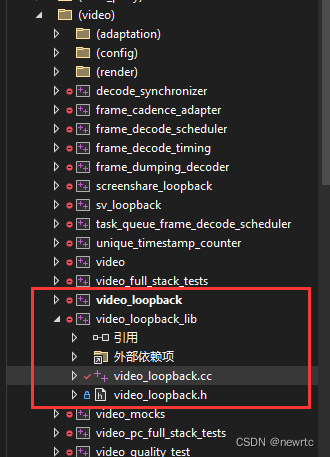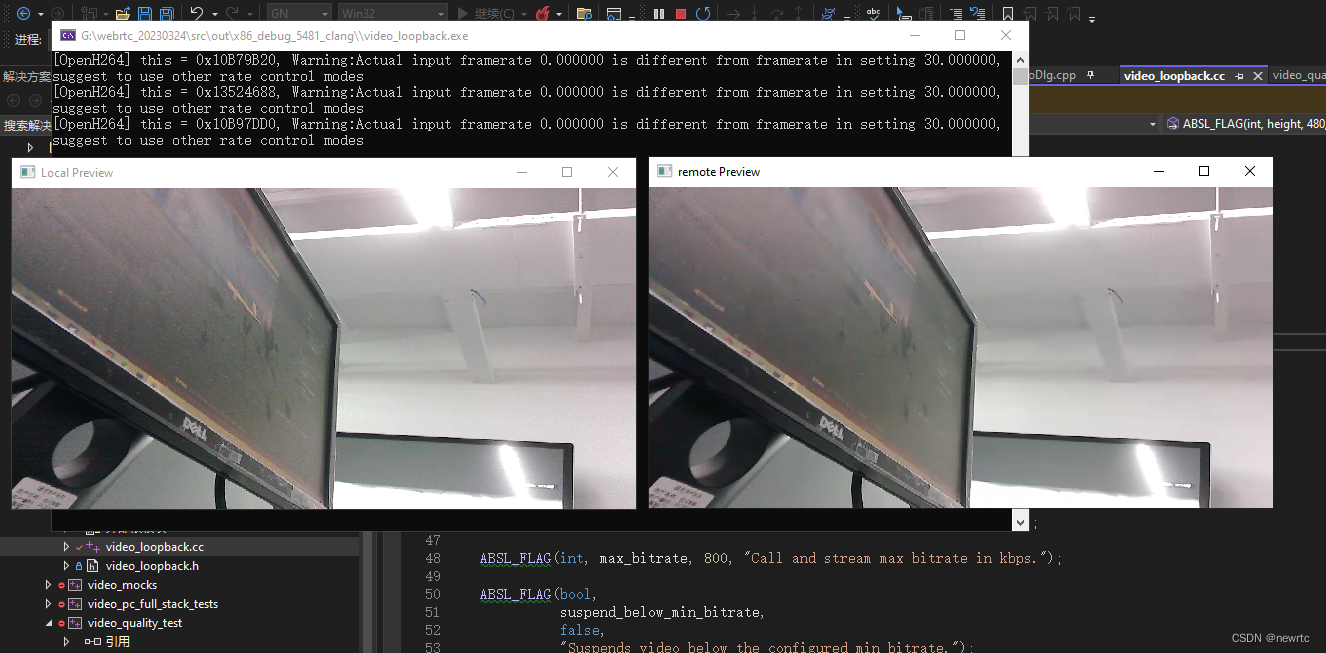- webrtc版本5841-m110
时间又过去了一年,再分析一下底层有什么改进,依然从video_loopback开始。
我想先不去看信令及协商的过程,只看媒体层有什么变化。所以从这个demo开始
video_loopback
项目路径 src/video/video_loopback
在video_loopback_main.cc 中就一个函数main,进入webrtc::RunLoopbackTest
video_loopback_lib

这个文件里面主要是测试功能的一些配置,列出我测试修改的几个
//修改编码用h264
// Flags common with screenshare loopback, with equal default values.
ABSL_FLAG(std::string, codec, "H264" /*"VP8"*/, "Video codec to use.");
//修改起音频测试
ABSL_FLAG(bool, audio, true, "Add audio stream");
//修改启用真实音频采集
ABSL_FLAG(bool,
use_real_adm,
true,/* false,*/
"Use real ADM instead of fake (no effect if audio is false)");
通过修改参数配置 我们可以跟踪调试,接下来跟踪webrtc::test::RunTest(webrtc::Loopback);
- Loopback() 这个函数就是初始化参数,我们简单看一下初始化的值是不是我们想要的,
- 进入 fixture->RunWithRenderers(params);
video_quality_test
主要的流程在video_quality_test.cc 里面
跟踪试试,运行就崩溃,和之前版本一样的问题,解决方法参考之前的文章
https://newrtc.blog.csdn.net/article/details/118379956

运行起来了,不过没有声音,哪里出了问题么,这demo越来越不负责了。我们先找找音频的问题再分析代码。
代码在video_quality_tesy.cc
先解决没有声音的问题,查看代码是使用了新的音频采集模块,不知道为什么没有声音,等有时间先去看看为什么要替换原来的coreaudio,莫非真的要刷kpi么。
上代码
rtc::scoped_refptr<AudioDeviceModule> VideoQualityTest::CreateAudioDevice() {
//增加这句,初始化的是原来的coreaudio采集方式
return AudioDeviceModule::Create(AudioDeviceModule::kPlatformDefaultAudio,
task_queue_factory_.get());
//这是新版的测试代码,大概跟踪了一下
#ifdef WEBRTC_WIN
RTC_LOG(LS_INFO) << "Using latest version of ADM on Windows";
// We must initialize the COM library on a thread before we calling any of
// the library functions. All COM functions in the ADM will return
// CO_E_NOTINITIALIZED otherwise. The legacy ADM for Windows used internal
// COM initialization but the new ADM requires COM to be initialized
// externally.
com_initializer_ =
std::make_unique<ScopedCOMInitializer>(ScopedCOMInitializer::kMTA);
RTC_CHECK(com_initializer_->Succeeded());
RTC_CHECK(webrtc_win::core_audio_utility::IsSupported());
RTC_CHECK(webrtc_win::core_audio_utility::IsMMCSSSupported());
return CreateWindowsCoreAudioAudioDeviceModule(task_queue_factory_.get());
#else
//这是原来的方式,可以正常使用
// Use legacy factory method on all platforms except Windows.
return AudioDeviceModule::Create(AudioDeviceModule::kPlatformDefaultAudio,
task_queue_factory_.get());
#endif
}
到此,demo的音视频都能够测试通过了,接下来开始代码流程
初始化过程
我们只看几个重要的函数
void VideoQualityTest::RunWithRenderers(const Params& params) {
//发送和接收的transport,继承自Transport,实现SendRtp,SendRtcp接口
std::unique_ptr<test::LayerFilteringTransport> send_transport;
std::unique_ptr<test::DirectTransport> recv_transport;
//渲染采集到的数据和解码后的数据yuv420p
std::unique_ptr<test::VideoRenderer> local_preview;
std::vector<std::unique_ptr<test::VideoRenderer>> loopback_renderers;
//初始化音频模块,这里创建了send call 和recv call两个call,其实可以创建一个
InitializeAudioDevice(&send_call_config, &recv_call_config,
params_.audio.use_real_adm);
//创建发送call 接收call
CreateCalls(send_call_config, recv_call_config);
//创建transport
send_transport = CreateSendTransport();
recv_transport = CreateReceiveTransport();
// TODO(ivica): Use two calls to be able to merge with RunWithAnalyzer or at
// least share as much code as possible. That way this test would also match
// the full stack tests better.
//设置transport的receiver,模拟网络接收的rtp,rtcp传递给call
send_transport->SetReceiver(receiver_call_->Receiver());
recv_transport->SetReceiver(sender_call_->Receiver());
//设置视频相关,设置一些配置。后续仔细分析
SetupVideo(send_transport.get(), recv_transport.get());
//创建视频流
CreateVideoStreams();
//创建视频采集
CreateCapturers();
//将采集关联到视频流
ConnectVideoSourcesToStreams();
//音频设置及创建音频流
SetupAudio(send_transport.get());
//开始测试
Start();
}
重要函数分析
先看音频的接收发送流程吧,视频的类似
1、音频设备初始化,在call 创建之前,
调用入口
InitializeAudioDevice(&send_call_config, &recv_call_config,
params_.audio.use_real_adm);
void VideoQualityTest::InitializeAudioDevice(Call::Config* send_call_config,
Call::Config* recv_call_config,
bool use_real_adm) {
rtc::scoped_refptr<AudioDeviceModule> audio_device;
if (use_real_adm) {
// Run test with real ADM (using default audio devices) if user has
// explicitly set the --audio and --use_real_adm command-line flags.
//我们测试参数设置用实际的音频设备,在此初始化
audio_device = CreateAudioDevice();
} else {
// By default, create a test ADM which fakes audio.
audio_device = TestAudioDeviceModule::Create(
task_queue_factory_.get(),
TestAudioDeviceModule::CreatePulsedNoiseCapturer(32000, 48000),
TestAudioDeviceModule::CreateDiscardRenderer(48000), 1.f);
}
RTC_CHECK(audio_device);
AudioState::Config audio_state_config;
audio_state_config.audio_mixer = AudioMixerImpl::Create();
audio_state_config.audio_processing = AudioProcessingBuilder().Create();
audio_state_config.audio_device_module = audio_device;
//把device设置为创建call的参数,多个call可以共用一个device
send_call_config->audio_state = AudioState::Create(audio_state_config);
recv_call_config->audio_state = AudioState::Create(audio_state_config);
if (use_real_adm) {
// The real ADM requires extra initialization: setting default devices,
// setting up number of channels etc. Helper class also calls
// AudioDeviceModule::Init().
//这里面是初始化设置,选取音频采集,播放设备
webrtc::adm_helpers::Init(audio_device.get());
} else {
audio_device->Init();
}
// Always initialize the ADM before injecting a valid audio transport.
RTC_CHECK(audio_device->RegisterAudioCallback(
send_call_config->audio_state->audio_transport()) == 0);
}
在CreateAudioDevice()中,调用AudioDeviceModule创建device
rtc::scoped_refptr<AudioDeviceModule> VideoQualityTest::CreateAudioDevice() {
return AudioDeviceModule::Create(AudioDeviceModule::kPlatformDefaultAudio,
task_queue_factory_.get());
}
调用webrtc::adm_helpers::Init(audio_device.get()); 设置音频设备
void Init(AudioDeviceModule* adm) {
RTC_DCHECK(adm);
RTC_CHECK_EQ(0, adm->Init()) << "Failed to initialize the ADM.";
// Playout device.
{
//设置播放设备ID,adm可以遍历有哪些设备的
if (adm->SetPlayoutDevice(AUDIO_DEVICE_ID) != 0) {
RTC_LOG(LS_ERROR) << "Unable to set playout device.";
return;
}
//初始化音频播放设备
if (adm->InitSpeaker() != 0) {
RTC_LOG(LS_ERROR) << "Unable to access speaker.";
}
// Set number of channels
bool available = false;
//双声道支持
if (adm->StereoPlayoutIsAvailable(&available) != 0) {
RTC_LOG(LS_ERROR) << "Failed to query stereo playout.";
}
if (adm->SetStereoPlayout(available) != 0) {
RTC_LOG(LS_ERROR) << "Failed to set stereo playout mode.";
}
}
// Recording device.
{
//设置麦克风id,同样adm可以设置ID
if (adm->SetRecordingDevice(AUDIO_DEVICE_ID) != 0) {
RTC_LOG(LS_ERROR) << "Unable to set recording device.";
return;
}
//初始化
if (adm->InitMicrophone() != 0) {
RTC_LOG(LS_ERROR) << "Unable to access microphone.";
}
// Set number of channels
bool available = false;
if (adm->StereoRecordingIsAvailable(&available) != 0) {
RTC_LOG(LS_ERROR) << "Failed to query stereo recording.";
}
if (adm->SetStereoRecording(available) != 0) {
RTC_LOG(LS_ERROR) << "Failed to set stereo recording mode.";
}
}
2、创建call
CreateCalls
void CallTest::CreateSenderCall(const Call::Config& config) {
auto sender_config = config;
sender_config.task_queue_factory = task_queue_factory_.get();
sender_config.network_state_predictor_factory =
network_state_predictor_factory_.get();
sender_config.network_controller_factory = network_controller_factory_.get();
sender_config.trials = &field_trials_;
sender_call_.reset(Call::Create(sender_config));
}
void CallTest::CreateReceiverCall(const Call::Config& config) {
auto receiver_config = config;
receiver_config.task_queue_factory = task_queue_factory_.get();
receiver_config.trials = &field_trials_;
receiver_call_.reset(Call::Create(receiver_config));
}
3、音频编码器设置
void VideoQualityTest::SetupAudio(Transport* transport) {
AudioSendStream::Config audio_send_config(transport);
audio_send_config.rtp.ssrc = kAudioSendSsrc;
// Add extension to enable audio send side BWE, and allow audio bit rate
// adaptation.
audio_send_config.rtp.extensions.clear();
//采用opus48k 双声道
audio_send_config.send_codec_spec = AudioSendStream::Config::SendCodecSpec(
kAudioSendPayloadType,
{"OPUS",
48000,
2,
{{"usedtx", (params_.audio.dtx ? "1" : "0")}, {"stereo", "1"}}});
if (params_.call.send_side_bwe) {
audio_send_config.rtp.extensions.push_back(
webrtc::RtpExtension(webrtc::RtpExtension::kTransportSequenceNumberUri,
kTransportSequenceNumberExtensionId));
audio_send_config.min_bitrate_bps = kOpusMinBitrateBps;
audio_send_config.max_bitrate_bps = kOpusBitrateFbBps;
audio_send_config.send_codec_spec->transport_cc_enabled = true;
// Only allow ANA when send-side BWE is enabled.
audio_send_config.audio_network_adaptor_config = params_.audio.ana_config;
}
audio_send_config.encoder_factory = audio_encoder_factory_;
SetAudioConfig(audio_send_config);
std::string sync_group;
if (params_.video[0].enabled && params_.audio.sync_video)
sync_group = kSyncGroup;
CreateMatchingAudioConfigs(transport, sync_group);
CreateAudioStreams();
}
4 创建音频stream
void CallTest::CreateAudioStreams() {
RTC_DCHECK(audio_send_stream_ == nullptr);
RTC_DCHECK(audio_receive_streams_.empty());
//通过call创建音频发送stream
audio_send_stream_ = sender_call_->CreateAudioSendStream(audio_send_config_);
for (size_t i = 0; i < audio_receive_configs_.size(); ++i) {
audio_receive_streams_.push_back(
//通过call创建音频接收stream
receiver_call_->CreateAudioReceiveStream(audio_receive_configs_[i]));
}
}
5 start音视频
void CallTest::Start() {
StartVideoStreams();
if (audio_send_stream_) {
//开始音频发送
audio_send_stream_->Start();
}
for (AudioReceiveStreamInterface* audio_recv_stream : audio_receive_streams_)
//开始音频接收
audio_recv_stream->Start();
}


